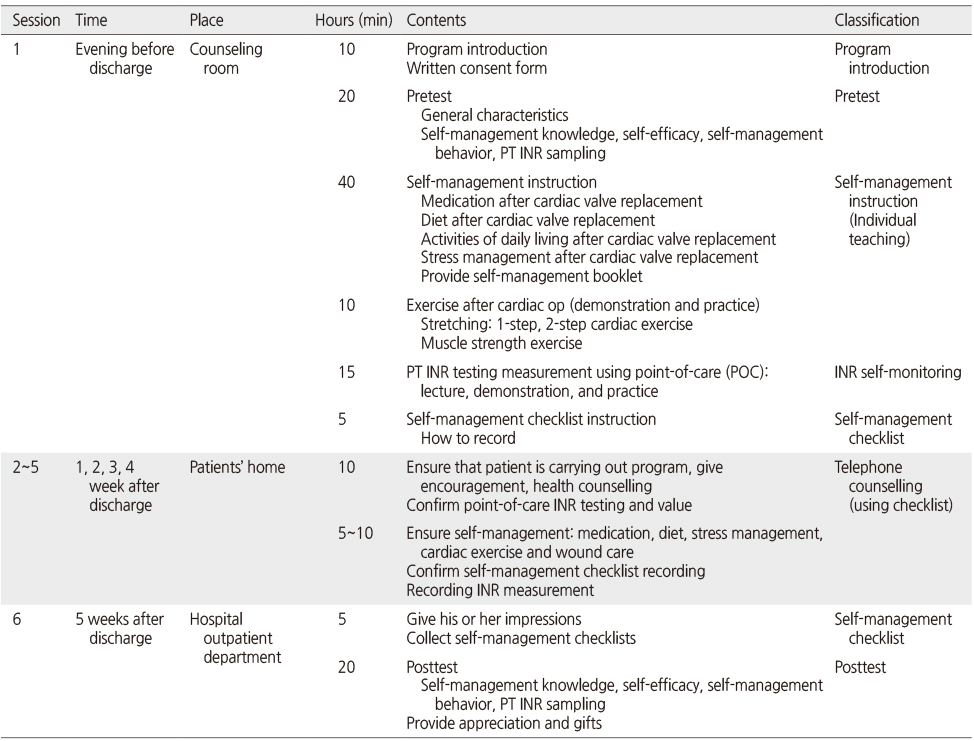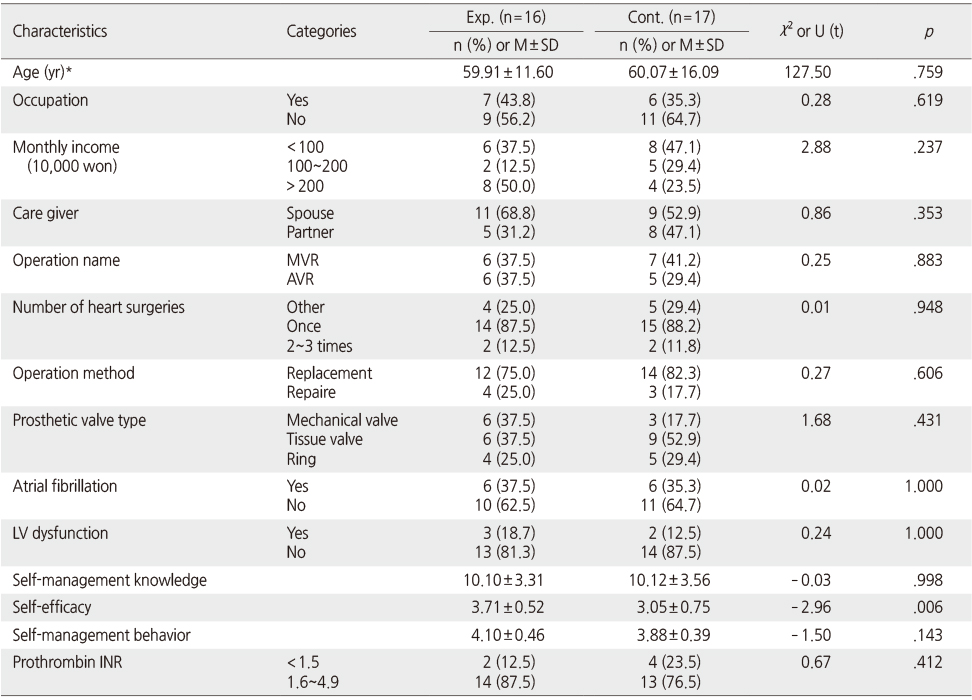Articles
- Page Path
- HOME > J Korean Acad Nurs > Volume 45(4); 2015 > Article
-
Original Article
- Development and Application of a Self-management Program based on Prothrombin INR Monitoring for Patients with Cardiac Valve Replacement
- Hyun Rye Jeon, Jeong Sook Park
-
Journal of Korean Academy of Nursing 2015;45(4):554-564.
DOI: https://doi.org/10.4040/jkan.2015.45.4.554
Published online: August 31, 2015
1Dongsan Medical Center, Keimyung University, Daegu, Korea.
2College of Nursing, Keimyung University, Daegu, Korea.
- Address reprint requests to: Park, Jeong Sook. College of Nursing, Keimyung University, 1095 Dalgubeoldae-ro, Dalseo-gu, Daegu 42601, Korea. Tel +82-53-580-3907, Fax +82-53-580-3916, jsp544@gw.kmu.ac.kr
© 2015 Korean Society of Nursing Science
This is an Open Access article distributed under the terms of the Creative Commons Attribution NoDerivs License. (http://creativecommons.org/licenses/by-nd/4.0/) If the original work is properly cited and retained without any modification or reproduction, it can be used and re-distributed in any format and medium.
Abstract
-
Purpose
- The purpose of this study was to develop and evaluate a self-management program based on INR monitoring for patients with cardiac valve replacement.
-
Methods
- This program was comprised of five weekly sessions based on Sousa's Enhance-Behavior Performance Model. The first session included individual teaching, and the other four sessions included Prothrombin Time International Normalized Ratios (PT INR) self-monitoring, telephone counseling and self-management checklist recording. Participants were patients who had cardiac valve replacement. They were randomly assigned to the experimental or control group. Sixteen in the experimental group participated in the self-management program and seventeen in the control group participated in general care. Self-management knowledge, self-efficacy, self-management behavior and PT INR were measured as dependent variables. Data were analyzed using Mann Whitney U-test, t-test and ANCOVA.
-
Results
- The experimental group showed significantly higher post-test scores in self-management knowledge (t=5.86, p <.001), self-efficacy (F=18.32, p <.001), and self-management behavior (t=3.44, p =.002) compared to the control group. Also, the experimental group showed significantly higher frequency in maintaining the treatment range of PT INR compared to the control group (χ2=4.80, p =.028).
-
Conclusion
- The results of the research on the self-management program based on PT INR monitoring showed that it is effective in improving self-management knowledge, self-efficacy, and self-management behavior as well as maintaining treatment range of PT INR of patients with cardiac valve replacement.
This manuscript is based on a part of the first author's doctoral dissertation from Keimyung University.
- 1. Statistics Korea. 2013 annual report on the cause of death statistics [Internet]. Daejeon, Author. 2014;cited 2014 December 13. Available from: http://kostat.go.kr/portal/korea/kor_nw/2/6/2/index.board?bmode=
- 2. The Korea Heart Foundation. 2014 current status of cardiac surgery [Internet]. Seoul, Author. 2015;cited 2014 December 13. Available from: http://www.heart.or.kr/korean/board/board.php?sa=list&bid=2
- 3. Hirsh J, Dalen J, Anderson DR, Poller L, Bussey H, Ansell J, et al. Oral anticoagulants: Mechanism of action, clinical effectiveness, and optimal therapeutic range. Chest. 2001;119:1 Suppl. 8S–21S.ArticlePubMed
- 4. Ansell J, Jacobson A, Levy J, Völler H, Hasenkam JM. Guidelines for implementation of patient self-testing and patient self-management of oral anticoagulation. International consensus guidelines prepared by international self-monitoring association for oral anticoagulation. Int J Cardiol. 2005;99(1):37–45. ArticlePubMed
- 5. Torn M, Rosendaal FR. Oral anticoagulation in surgical procedures: Risks and recommendations. Br J Haematol. 2003;123(4):676–682.ArticlePubMedPDF
- 6. Mair H, Sachweh J, Sodian R, Brenner P, Schmoeckel M, Schmitz C, et al. Long-term self-management of anticoagulation therapy after mechanical heart valve replacement in outside trial conditions. Interact Cardiovasc Thorac Surg. 2012;14(3):253–257. ArticlePubMed
- 7. Park R, Kim YH, Kwon KO, Na J, Won YS, Sung KB, et al. Utility of CoaguChek XS for monitoring the prothrombin time. Tuberc Respir Dis. 2008;65(6):471–475. Article
- 8. Kim JH, Kim GS, Kim EJ, Park S, Chung N, Chu SH. Factors affecting medication adherence and anticoagulation control in Korean patients taking warfarin. J Cardiovasc Nurs. 2011;26(6):466–474. ArticlePubMed
- 9. Lee YS, Jung HM. The effect of cardiac rehabilitation education on self-care knowledge and self-care behavior in open heart surgery patients after hospital discharge. Clin Nurs Res. 2003;9(1):29–40.
- 10. Choo J, Kim JM, Hong KP. Effects of TES program on exercise capacity, self-efficacy and patient compliance in patients with myocardial infarction. J Korean Acad Nurs. 2003;33(7):905–916.ArticlePDF
- 11. Gi MY, Park YH. The effects of hypertension self-help program on hypertension-related knowledge, self-efficacy, self-management compliance and physiological parameters in workers. Korean J Occup Health Nurs. 2012;21(1):1–9.Article
- 12. Gardiner C, Longair I, Pescott MA, Erwin H, Hills J, Machin SJ, et al. Self-monitoring of oral anticoagulation: Does it work outside trial conditions? J Clin Pathol. 2009;62(2):168–171. ArticlePubMed
- 13. Jo HS, Kim KJ. The effects of a cardiac rehabilitation program on health behavior compliance, cardiovascular function, and quality of life for the patients with ischemic heart disease. J Korean Acad Nurs. 2000;30(3):560–570.ArticlePDF
- 14. Cho HY, Kim HS. Effects of individualized cardiac health education on self care behavior and serum cholesterol in patients with coronary artery disease. J Korean Acad Adult Nurs. 2010;22(3):322–328.
- 15. Korean Society of Cardiology. The textbook of cardiovascular medicine. Seoul: Author; 2004.
- 16. Cranwell-Bruce LA. Anticoagulation therapy: Reinforcing patient education. Medsurg Nursing. 2007;16(1):55–58.PubMed
- 17. Jung YS. Effects of phase 1 cardiac rehabilitation program on self-efficacy and performance of health behavior in acute myocardial infarction patients [master's thesis]. Seoul, Seoul National University. 2002.
- 18. Jang SR. A study on the relationship between drug-related knowledge and sick role behavior of patients under anticoagulant therapy [master's thesis]. Seoul, Yonsei University. 2007.
- 19. Sousa VD, Zauszniewski JA, Musil CM, McDonald PE, Milligan SE. Testing a conceptual framework for diabetes self-care management. Res Theory Nurs Pract. 2004;18(4):293–316.ArticlePubMed
- 20. Bonow RO, Carabello BA, Chatterjee K, de Leon AC Jr, Faxon DP, Freed MD, et al. 2008 focused update incorporated into the ACC/AHA 2006 guidelines for the management of patients with valvular heart disease: A report of the American College of Cardiology/American Heart Association Task Force on Practice Guidelines (Writing Committee to revise the 1998 guidelines for the management of patients with valvular heart disease). Endorsed by the Society of Cardiovascular Anesthesiologists, Society for Cardiovascular Angiography and Interventions, and Society of Thoracic Surgeons. J Am Coll Cardiol. 2008;52(13):e1–e142. PubMed
- 21. Ly J. INR monitoring protocol for warfarin therapy: Practice tool helps patients monitor themselves. Can Pharm J (Ott). 2005;138(6):43–44.
- 22. Thompson PD, Buchner D, Pina IL, Balady GJ, Williams MA, Marcus BH, et al. Exercise and physical activity in the prevention and treatment of atherosclerotic cardiovascular disease: A statement from the Council on Clinical Cardiology (Subcommittee on Exercise, Rehabilitation, and Prevention) and the Council on Nutrition, Physical Activity, and Metabolism (Subcommittee on Physical Activity). Circulation. 2003;107(24):3109–3116. ArticlePubMed
- 23. Ansell J. Point-of-care patient self-monitoring of oral vitamin K antagonist therapy. J Thromb Thrombolysis. 2013;35(3):339–341. ArticlePubMedPDF
- 24. Christensen TD, Attermann J, Pilegaard HK, Andersen NT, Maegaard M, Hasenkam JM. Self-management of oral anticoagulant therapy for mechanical heart valve patients. Scand Cardiovasc J. 2001;35(2):107–113.ArticlePubMed
- 25. Goldberg H, Gordon L, David YB, Baevsky T, Brezis M. Feasibility of pre-discharge training in the self-management of oral anticoagulation. J Eval Clin Pract. 2010;16(3):661–664. ArticlePubMed
- 26. Jeong HS, Kim HS, Yoo YS, Moon JS. Effects of cardiac rehabilitation teaching program on knowledge level and compliance of health behavior for patients with myocardial infarction. J Korean Acad Nurs. 2002;32(1):50–61.ArticlePDF
- 27. McCahon D, Murray ET, Murray K, Holder RL, Fitzmaurice DA. Does self-management of oral anticoagulation therapy improve quality of life and anxiety? Fam Pract. 2011;28(2):134–140. ArticlePubMed
- 28. Kim CG, Chung CH. Effects of telephone consulting program on self-efficacy and self-care in NIDDM patients. J Korean Acad Adult Nurs. 2002;14(2):306–314.
- 29. Lee JS. Development and evaluation of cardiac rehabilitation program for coronary artery bypass grafting patients [dissertation]. Seoul, Seoul National University. 2008.
- 30. Kim H, Kim S. Effects of an integrated self-management program on self-management, glycemic control, and maternal identity in women with gestational diabetes mellitus. J Korean Acad Nurs. 2013;43(1):69–80. ArticlePubMed
REFERENCES
Self-management Program based on Prothrombin INR Monitoring for Patients with Cardiac Valve Replacement

Figure & Data
REFERENCES
Citations

- Factors Influencing Health-Related Quality of Life in Patients With Atrial Fibrillation
Hyeon-Ok Lee, Ji-Yeong Seo
Journal of Cardiovascular Nursing.2025;[Epub] CrossRef - Self-care Behavior Based on Integrated Behavioral Model in Patients With Atrial Fibrillation: A Structural Equation Modeling Approach
Juhyun Song, Seung Yong Shin, Kyunghee Kim, Youn-Jung Son, Jisu Kim, Insil Jang
Western Journal of Nursing Research.2024; 46(2): 114. CrossRef - The Impact of Self-Management Behaviors, Self-Efficacy, and Grit on Health-related Quality of Life in Patients with Atrial Fibrillation: A Cross-Sectional Descriptive Study
Ji-Yeong Seo, Hyeon-Ok Lee
Korean Journal of Adult Nursing.2023; 35(2): 158. CrossRef - Effects of eHealth Interventions on Quality of Life and Psychological Outcomes in Cardiac Surgery Patients: Systematic Review and Meta-analysis
Ruping Ni, Maobai Liu, Shunmin Huang, Jing Yang
Journal of Medical Internet Research.2022; 24(8): e40090. CrossRef - Combining portable coagulometers with the Internet: A new model of warfarin anticoagulation in patients following mechanical heart valve replacement
Yu Huang, Lei Huang, Zhen Han
Frontiers in Surgery.2022;[Epub] CrossRef - Individualized education focusing on self‐management improved the knowledge and self‐management behaviour of elderly people with atrial fibrillation: A randomized controlled trial
Yun Hee Oh, Seon Young Hwang
International Journal of Nursing Practice.2021;[Epub] CrossRef - Effects of Insambaekhab-tang on International Normalized Ratio Levels in a Cardioembolic Stroke Patient Taking Warfarin
Cheol-hyun Kim, Kwangho Kim, Young-ung Lee, Sunny Kang
Journal of Korean Medical Society of Soft Tissue.2021; 5(1): 96. CrossRef - Effect of Self-Management Program on Self-efficacy and Medication Adherence in Patients with Mechanical Heart Valve: a Randomized Clinical Trial
Leila Javan, Aanoshirvan Kazemnejad, Mahin Nomali, Maasumeh Zakerimoghadam
Journal of Caring Sciences.2019; 8(4): 207. CrossRef
Self-management Program based on Prothrombin INR Monitoring for Patients with Cardiac Valve Replacement
*op=operation; PT INR=Prothrombin time international normalized ratio.
Homogeneity Test of General Characteristics and Dependent Variables (N=33)
*Mann Whitney U-test; Exp.=Experimental group; Cont.=Control group; MVR=Mitral valve replacement; AVR=Aortic valve replacement; LV=Left ventricle; INR=International normalized ratio.
Effect of Self-management Program based on PT INR Monitoring in Self-management Knowledge, Self-efficacy, and Self-management Behavior (N=33)
*Covariate mean pre self-efficiency score; Exp.=Experimental group (n=16); Cont.=Control group (n=17); PT INR=Prothrombin time international normalized ratio.
Effect of Self-management Program based on PT INR Monitoring in Prothrombin INR (N=32)
*1 patient in the control group did not do post PT INR; Exp.= Experimental group; Cont.=Control group; PT INR=Prothrombin time international normalized ratio.
*op=operation; PT INR=Prothrombin time international normalized ratio.
*Mann Whitney U-test; Exp.=Experimental group; Cont.=Control group; MVR=Mitral valve replacement; AVR=Aortic valve replacement; LV=Left ventricle; INR=International normalized ratio.
*Covariate mean pre self-efficiency score; Exp.=Experimental group (n=16); Cont.=Control group (n=17); PT INR=Prothrombin time international normalized ratio.
*1 patient in the control group did not do post PT INR; Exp.= Experimental group; Cont.=Control group; PT INR=Prothrombin time international normalized ratio.
 KSNS
KSNS
 E-SUBMISSION
E-SUBMISSION



 Cite
Cite

